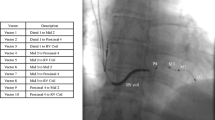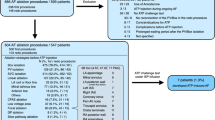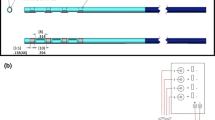Abstract
Transcatheter pulmonary artery denervation (PADN) has been developed for the correction of pulmonary hypertension. We investigated pulmonary artery stimulation mapping and its role in PADN procedures. Artery stimulation was performed in 17 Landrace pigs. Low-frequency stimulation defined areas of ventricular and atrial capture. High-frequency stimulation evoked the following responses: sinus rhythm slowing and/or atrial rhythm acceleration in 59% of animals, phrenic nerve capture in 100%, and laryngeal recurrent nerve capture in 23%. The sites with evoked heart rate responses were marked by discrete radiofrequency ablations (RFA). An autopsy showed nerves in the adventitia and perivascular fat under the RFA sites, and the lack of muscarinic-1, tyrosine hydroxylase, and dopamine-5 receptors’ expression. During PADN, areas adjacent to the course of phrenic and recurrent laryngeal nerves should be avoided. RFA at points with heart rate responses leads to the non-reproducibility of evoked reactions and the disappearance of neural markers’ expression.

Graphical abstract






Similar content being viewed by others
Abbreviations
- CVP:
-
Central venous pressure
- HFS:
-
High-frequency stimulation
- ISABP:
-
Invasive systemic arterial blood pressure
- LFS:
-
Low-frequency stimulation
- mPAP:
-
Mean pulmonary artery pressure
- PA:
-
Pulmonary artery
- PADN:
-
Pulmonary artery denervation
- PAH:
-
Pulmonary arterial hypertension
- PAP:
-
Pulmonary artery pressure
- RFA:
-
Radiofrequency ablation
References
Ginoux, M., Turquier, S., Chebib, N., Glerant, J. C., Traclet, J., Philit, F., Sénéchal, A., Mornex, J. F., & Cottin, V. (2018). Impact of comorbidities and delay in diagnosis in elderly patients with pulmonary hypertension. ERJ Open Res., 4, 00100–02018.
Velez-Roa, S., Ciarka, A., Najem, B., Vachiery, J. L., Naeije, R., & van de Borne, P. (2004). Increased sympathetic nerve activity in pulmonary artery hypertension. Circulation., 110, 1308–1312.
Rudner, X. L., Berkowitz, D. E., Booth, J. V., Funk, B. L., Cozart, K. L., D'Amico, E. B., El-Moalem, H., Page, S. O., Richardson, C. D., Winters, B., Marucci, L., & Schwinn, D. A. (1999). Subtype specific regulation of human vascular alpha(1)-adrenergic receptors by vessel bed and age. Circulation., 100, 2336–2343.
Chen, S. L., Zhang, F. F., Xu, J., Xie, D. J., Zhou, L., Nguyen, T., & Stone, G. W. (2013). Pulmonary artery denervation to treat pulmonary arterial hypertension: the single-center, prospective, first-in-man PADN-1 study (first-in-man pulmonary artery denervation for treatment of pulmonary artery hypertension). Journal of the American College of Cardiology, 62, 1092–1100.
Rothman, A. M., Arnold, N. D., Chang, W., Watson, O., Swift, A. J., Condliffe, R., Elliot, C. A., Kiely, D. G., Suvarna, S. K., Gunn, J., & Lawrie, A. (2015). Pulmonary artery denervation reduces pulmonary artery pressure and induces histological changes in an acute porcine model of pulmonary hypertension. Circulation. Cardiovascular Interventions, 8, e002569.
Fujisawa, T., Kataoka, M., Kawakami, T., Isobe, S., Nakajima, K., Kunitomi, A., Kashimura, S., Katsumata, Y., Nishiyama, T., Kimura, T., Nishiyama, N., Aizawa, Y., Murata, M., Fukuda, K., & Takatsuki, S. (2017). Pulmonary artery denervation by determining targeted ablation sites for treatment of pulmonary arterial hypertension. Circulation. Cardiovascular Interventions, 10, e005812.
Goncharova, N. S., Moiseeva, O. M., Condori Leandro, H. I., Zlobina, I. S., Berezina, A. V., Malikov, K. N., Tashkhanov, D. M., Lebedev, D. S., & Mikhaylov, E. N. (2020). Electrical stimulation-guided approach to pulmonary artery catheter ablation in patients with idiopathic pulmonary arterial hypertension: a pilot feasibility study with a 12-month follow-up. BioMed Research International, 2020, 8919515.
Chen, S. L., Zhang, H., Xie, D. J., Zhang, J., Zhou, L., Rothman, A. M., & Stone, G. W. (2015). Hemodynamic, functional, and clinical responses to pulmonary artery denervation in patients with pulmonary arterial hypertension of different causes: phase II results from the Pulmonary Artery Denervation-1 Study. Circulation. Cardiovascular Interventions, 8, e002837.
Roehl, A. B., Steendijk, P., Baumert, J. H., Schnoor, J., Rossaint, R., & Hein, M. (2009). Comparison of 3 methods to induce acute pulmonary hypertension in pigs. Comparative Medicine, 59, 280–286.
Singh, I., Oliveira, R. K. F., Naeije, R., Rahaghi, F. N., Oldham, W. M., Systrom, D. M., & Waxman, A. B. (2019). Pulmonary vascular distensibility and early pulmonary vascular remodeling in pulmonary hypertension. Chest., 156, 724–732.
Mitrofanova, L. B., Gorshkov, A. N., Lebedev, D. S., & Mikhaylov, E. N. (2014). Evidence of specialized tissue in human interatrial septum: histological, immunohistochemical and ultrastructural findings. PLoS One, 9, e113343.
Scherlag, B. J., Yamanashi, W. S., Schauerte, P., Scherlag, M., Sun, Y. X., Hou, Y., Jackman, W. M., & Lazzara, R. (2002). Endovascular stimulation within the left pulmonary artery to induce slowing of heart rate and paroxysmal atrial fibrillation. Cardiovascular Research, 54, 470–475.
Ramos-Villalobos, L. E., Colin Lizalde, L., Márquez, M. F., Iturralde, P., & Castillo, F. (2017). Postintervention dyspnea after radiofrequency catheter ablation: think of a phrenic nerve injury. Case Reports in Cardiology, 2017, 6418070.
Swallow, E. B., Dayer, M. J., Oldfield, W. L., Moxham, J., & Polkey, M. I. (2006). Right hemi-diaphragm paralysis following cardiac radiofrequency ablation. Respiratory Medicine, 100, 1657–1659.
Pai, R. K., Boyle, N. G., Child, J. S., & Shivkumar, K. (2005). Transient left recurrent laryngeal nerve palsy following catheter ablation of atrial fibrillation. Heart Rhythm, 2, 182–184.
Romero, J., Natale, A., Lakkireddy, D., Cerna, L., Diaz, J. C., Alviz, I., Cerrud-Rodriguez, R. C., Grupposo, V., Rios, S. A., Chernobelsky, E., Elsayed, M. G., Garcia, M., & Di Biase, L. (2020). Mapping and localization of the left phrenic nerve during left atrial appendage electrical isolation to avoid inadvertent injury in patients undergoing catheter ablation of atrial fibrillation. Heart Rhythm, 17, 527–534.
Tan, A. Y., Li, H., Wachsmann-Hogiu, S., Chen, L. S., Chen, P. S., & Fishbein, M. C. (2006). Autonomic innervation and segmental muscular disconnections at the human pulmonary vein-atrial junction: implications for catheter ablation of atrial-pulmonary vein junction. Journal of the American College of Cardiology, 48, 132–143.
Acknowledgments
The authors thank Lada A. Murashova, VMD, and Stepan E. Voronin, VMD, for their technical assistance and support in experiment organization.
Funding
The study has been supported by the grant from the Ministry of Science and Higher Education of the Russian Federation (agreement #075-15-2020-800). The funding authority had no impact on the study design nor in the interpretation of the results.
Author information
Authors and Affiliations
Contributions
NSG, OMM, DSL, and ENM contributed to the study conception and design. Material preparation, data collection, and analysis were performed by HICL, ADV, NSG, LEK, EGK, LBM, EMA, and ENM. The first draft of the manuscript was written by HICL, ADV, NSG, and ENM, and all authors commented on the manuscript. All authors read and approved the final manuscript version.
Corresponding author
Ethics declarations
Conflict of Interest
Author ENM has received speakers and consultation honoraria from Biosense Webster. The other authors declare that they have no conflicts of interest.
Ethical Approval
All institutional and national guidelines for the care and use of laboratory animals were followed and approved by the appropriate institutional committees.
Additional information
Associate Editor Marat Fudim oversaw the review of this article
Publisher’s Note
Springer Nature remains neutral with regard to jurisdictional claims in published maps and institutional affiliations.
Rights and permissions
About this article
Cite this article
Condori Leandro, H., Vakhrushev, A.D., Goncharova, N.S. et al. Stimulation Mapping of the Pulmonary Artery for Denervation Procedures: an Experimental Study. J. of Cardiovasc. Trans. Res. 14, 546–555 (2021). https://doi.org/10.1007/s12265-020-10079-4
Received:
Accepted:
Published:
Issue Date:
DOI: https://doi.org/10.1007/s12265-020-10079-4




